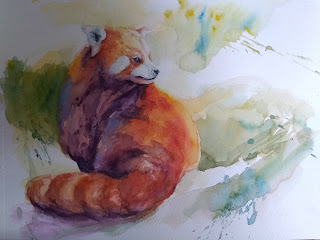Notes from Media Literacy (I)
Chapter 2: Preface to the Myth of the Liberal Media (Noam Chomsky)
Historically political/economical elites have tried to grant limited rights to the public. In the U.S., this tendency is well reflected in the market control of media. According to Edward Herman, the audiences are the "product" sold to markets all linked to state power.
Chapter 3: Word Tricks and Propaganda (Edward Herman)
Frame works of the usage of words to serve state propaganda. (1) Purring: reform, responsible, flexible, national security, moderate, etc. (2) Snarling: extremist, terrorist, dictator, welfare(--why is this a snarling word?). Provokes public anger. (3) Putdowns: less aggressive words, such as noisy leftist vs. quiet neoliberalist. (4) Playing down violence: violence executed by the state or client state is described only "tough" action in the pursuit of security, thus justified. (5) Obscuring appeasement of client state terror: commercial diplomacy, quiet diplomacy, constructive engagement. Terror in client state is not harmful. (6) Facilitating innuendo: linked, is reported, official claims, etc. Without providing supporting evidences, it aggravates existing biases. (7) Personification and use of collective words: commonly employed to get across preferred positions by insinuating they are the opinion of the majority. (8) Falsely imputing benevolent motives: "risk" or "gamble", which describes the government's good economic drive for the poor, while the government never takes a risk. (9) Removing agency: media doesn't reveal the responsible for death toll in civil wars or national terrors if it is performed by client states.
Chapter 4: Toward a democratic media (Edward Herman)
In order to achieve media sovereignty of the public against freedom of choice, Herman proposes democratic media both in structural and functional aspects. But since the structure determines the functions in the long run, he suggests empowering civic sectors above all, restructuring public sectors, which is run via government subsidy, and decreasing commercial sectors. Among alternative media, it is important to note that the internet, in spite of its great potential to reach wide audience, is geared toward elites and requires affordability of the population. So, to reach mass audience, mass movement, social forces and policy enforcement are required. (I agree!) Also when it comes to technology, the problem of catch-up, which means those with money and power get precedence to new technology, poses perpetual handicap to the public. Therefore media democrats should be keenly aware of the technology advance to cope with the main stream media, which usually are well equipped with more advanced technology.
This chapter reminds me of my long-forgotten dream, media activist. What a time lapse!
Chapter 5: Ciritical media literacy (Pepi Leistyna and Loretta Alper)
A critical media literacy is to develop an understanding culture propagated through media as a symbolic system that consists of ideology, power, meaning and identity. On this basis, the authors examines TV entertainment programs from the perspective of working class people. The importance of critical media literacy is in that culture along with a structural reality shapes people's political consciousness.
Historically political/economical elites have tried to grant limited rights to the public. In the U.S., this tendency is well reflected in the market control of media. According to Edward Herman, the audiences are the "product" sold to markets all linked to state power.
Chapter 3: Word Tricks and Propaganda (Edward Herman)
Frame works of the usage of words to serve state propaganda. (1) Purring: reform, responsible, flexible, national security, moderate, etc. (2) Snarling: extremist, terrorist, dictator, welfare(--why is this a snarling word?). Provokes public anger. (3) Putdowns: less aggressive words, such as noisy leftist vs. quiet neoliberalist. (4) Playing down violence: violence executed by the state or client state is described only "tough" action in the pursuit of security, thus justified. (5) Obscuring appeasement of client state terror: commercial diplomacy, quiet diplomacy, constructive engagement. Terror in client state is not harmful. (6) Facilitating innuendo: linked, is reported, official claims, etc. Without providing supporting evidences, it aggravates existing biases. (7) Personification and use of collective words: commonly employed to get across preferred positions by insinuating they are the opinion of the majority. (8) Falsely imputing benevolent motives: "risk" or "gamble", which describes the government's good economic drive for the poor, while the government never takes a risk. (9) Removing agency: media doesn't reveal the responsible for death toll in civil wars or national terrors if it is performed by client states.
Chapter 4: Toward a democratic media (Edward Herman)
In order to achieve media sovereignty of the public against freedom of choice, Herman proposes democratic media both in structural and functional aspects. But since the structure determines the functions in the long run, he suggests empowering civic sectors above all, restructuring public sectors, which is run via government subsidy, and decreasing commercial sectors. Among alternative media, it is important to note that the internet, in spite of its great potential to reach wide audience, is geared toward elites and requires affordability of the population. So, to reach mass audience, mass movement, social forces and policy enforcement are required. (I agree!) Also when it comes to technology, the problem of catch-up, which means those with money and power get precedence to new technology, poses perpetual handicap to the public. Therefore media democrats should be keenly aware of the technology advance to cope with the main stream media, which usually are well equipped with more advanced technology.
This chapter reminds me of my long-forgotten dream, media activist. What a time lapse!
Chapter 5: Ciritical media literacy (Pepi Leistyna and Loretta Alper)
A critical media literacy is to develop an understanding culture propagated through media as a symbolic system that consists of ideology, power, meaning and identity. On this basis, the authors examines TV entertainment programs from the perspective of working class people. The importance of critical media literacy is in that culture along with a structural reality shapes people's political consciousness.


Comments